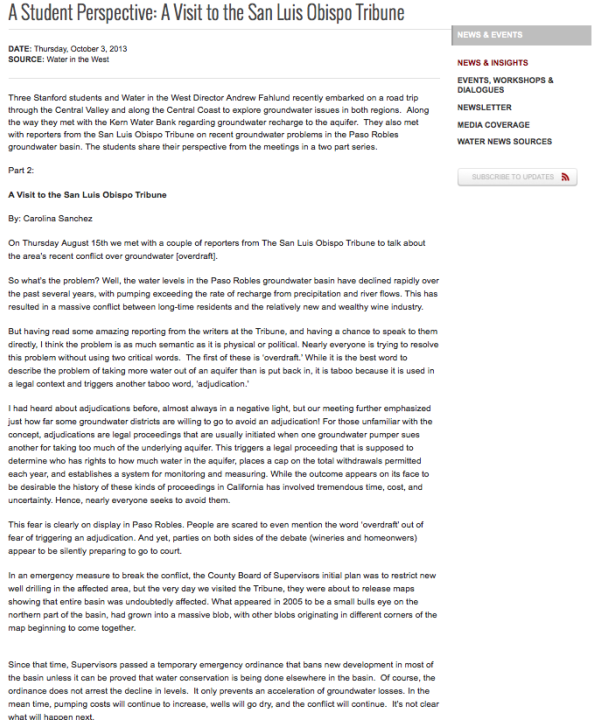October 03, 2013 | Water in the West | Insights
Three Stanford students and Water in the West Director Andrew Fahlund recently embarked on a road trip through the Central Valley and along the Central Coast to explore groundwater issues in both regions. Along the way they met with the Kern Water Bank regarding groundwater recharge to the aquifer. They also met with reporters from the San Luis Obispo Tribune on recent groundwater problems in the Paso Robles groundwater basin. The students share their perspective from the meetings in a two part series.
Part 2:
A Visit to the San Luis Obispo Tribune
By: Carolina Sanchez
On Thursday August 15th we met with a couple of reporters from The San Luis Obispo Tribune to talk about the area’s recent conflict over groundwater [overdraft].
So what’s the problem? Well, the water levels in the Paso Robles groundwater basin have declined rapidly over the past several years, with pumping exceeding the rate of recharge from precipitation and river flows. This has resulted in a massive conflict between long-time residents and the relatively new and wealthy wine industry.
But having read some amazing reporting from the writers at the Tribune, and having a chance to speak to them directly, I think the problem is as much semantic as it is physical or political. Nearly everyone is trying to resolve this problem without using two critical words. The first of these is ‘overdraft.’ While it is the best word to describe the problem of taking more water out of an aquifer than is put back in, it is taboo because it is used in a legal context and triggers another taboo word, ‘adjudication.’
I had heard about adjudications before, almost always in a negative light, but our meeting further emphasized just how far some groundwater districts are willing to go to avoid an adjudication! For those unfamiliar with the concept, adjudications are legal proceedings that are usually initiated when one groundwater pumper sues another for taking too much of the underlying aquifer. This triggers a legal proceeding that is supposed to determine who has rights to how much water in the aquifer, places a cap on the total withdrawals permitted each year, and establishes a system for monitoring and measuring. While the outcome appears on its face to be desirable the history of these kinds of proceedings in California has involved tremendous time, cost, and uncertainty. Hence, nearly everyone seeks to avoid them.
This fear is clearly on display in Paso Robles. People are scared to even mention the word ‘overdraft’ out of fear of triggering an adjudication. And yet, parties on both sides of the debate (wineries and homeonwers) appear to be silently preparing to go to court.
In an emergency measure to break the conflict, the County Board of Supervisors initial plan was to restrict new well drilling in the affected area, but the very day we visited the Tribune, they were about to release maps showing that entire basin was undoubtedly affected. What appeared in 2005 to be a small bulls eye on the northern part of the basin, had grown into a massive blob, with other blobs originating in different corners of the map beginning to come together.
Since that time, Supervisors passed a temporary emergency ordinance that bans new development in most of the basin unless it can be proved that water conservation is being done elsewhere in the basin. Of course, the ordinance does not arrest the decline in levels. It only prevents an acceleration of groundwater losses. In the mean time, pumping costs will continue to increase, wells will go dry, and the conflict will continue. It’s not clear what will happen next.
The reporters at the Tribune are doing an amazing job telling a complex story by describing geologic and hydrologic processes, arcane legal concepts, and emotional human events. Watching them work makes one even more disheartened by the decline of local newspapers. Hopefully they’ll continue to report on this for many years to come. It is clear, the story is going to last that long.
If you are interested in this topic, there are several articles about wine and water on the San Luis Obispo Tribune website. http://www.sanluisobispo.com/904/index.html
Carolina is currently earning her Masters of Science in Environmental Fluid Mechanics and Hydrology in the Civil and Environmental Engineering Department at Stanford University. She will graduate in December 2013.


![[Woods Logo]](/sites/default/files/logos/footer-logo-woods.png)
![[Bill Lane Center Logo]](/sites/default/files/logos/footer-logo-billlane.png)